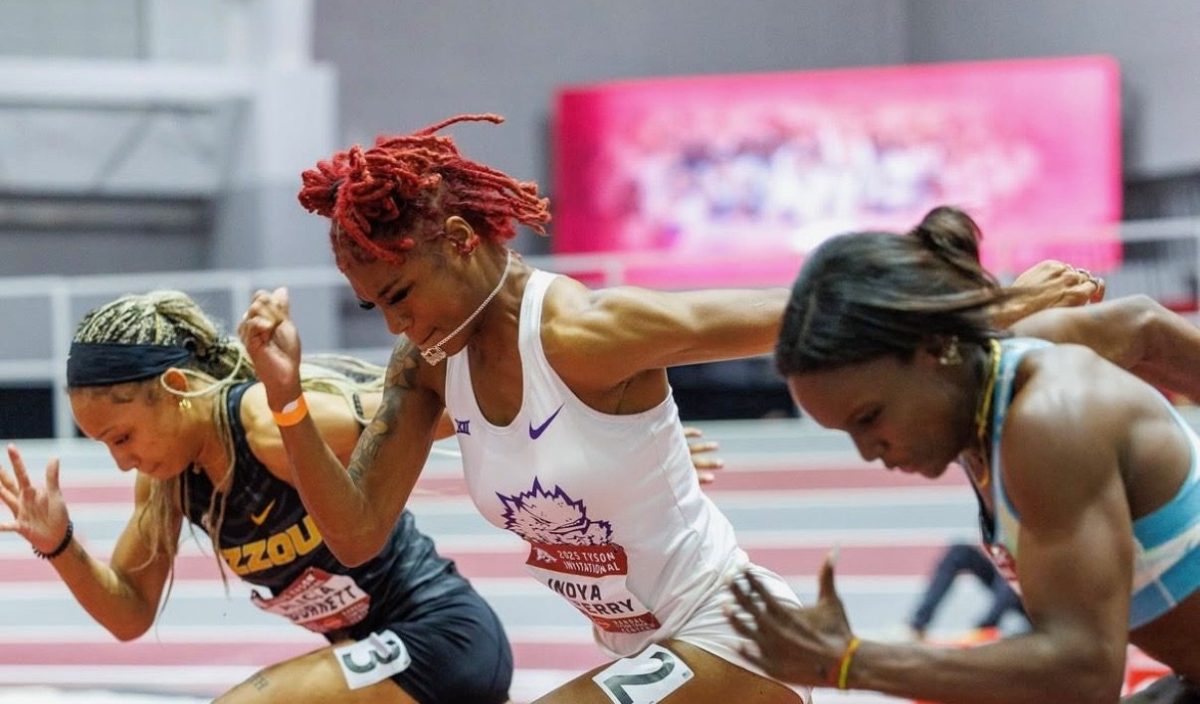A long jumper is a lot like an airplane, driving down the runway, taking off into the air and then landing.
The difference being airplanes don’t dive into a sandpit seconds after takeoff.
From the opening sprint to the landing finish, long jumping is a skill that requires a lot of “attention to detail,” senior jumper Ramone Bailey said.
“It’s very technical,” he said. “You need to work on your craft and hone your skill.”
Fine-tuning the technicalities is what TCU long jumpers have been striving for, evidenced by the team’s success in the past three years.
Every year since 2012, TCU has produced a long jumper who would claim either a conference or national title. Whitney Gipson was both NCAA Indoor and Outdoor Champion in 2012. Lorraine Ugen was the NCAA Outdoor Champion in 2013 and the Indoor Champion in 2014.
In February, Cameron Echols-Luper leaped a 24-11 3/4 (7.61 meters) to claim the Big 12 Indoor title.
The man behind the success of Ugen and Echols-Luper is assistant coachShawn Jackson. Jackson said the key to a successful jump is positioning the body so that the most force is used to propel forward.
The first step is to establish a fast sprint down the runway, which creates more momentum for a further jump, he said.
That’s why track head coach Darryl Anderson made Gipson do a lot of sprinting during her time at TCU, Gipson said.
Gipson, who competed for TCU from 2009 to 2012, also competed in the 200-meter dash and 4×100 relay.
“You can’t just be a jumper,” she said. “You have to sprint because the cadence in the 200 meters is the same cadence as being on the runway.”
Jackson said the second to last step before reaching the board, the penultimate step, is where things get tricky. The penultimate step is the moment when the jumper begins to lower his or her body before jumping off the board.
However, Jackson said jumpers tend to exaggerate the penultimate step, causing the hips to get too low and diminishing the power of the jump.
To remedy this issue, he said the jumper should ideally take a longer stride followed by a shorter step. Jumping off the board with a shorter step would create more power to push up.
Once at the board, Jackson said the jumper can also add more power if he or she starts from the heel rather than the toe.
Rather than jumping from the tip of the toe, Jackson said putting the heel down first will create more force to push upward.
When airborne, the jumper has options. One option is to “hitch-kick,” or take off in a running motion in the air. Another option is to “hang,” or throw the arms into the air and descend into the sand.
Echols-Luper does a mix of both, Jackson said.
“Cam initially hitches,” he said. “He hitches, but what happens is he’s in between the two of them. He’s a ‘hitch hanger.’”
Jackson said Echols-Luper’s asset is his natural speed, which stems from also being a football player.
Echols-Luper, who played wide receiver, was also the starting punt returner for TCU in the 2014 season. He will switch to cornerback for the 2015 season.
“The hardest thing to teach is actually the easiest thing to teach with Luper because he can naturally do it,” Jackson said. “He’s naturally good on the runway.”
Men’s Long Jump Final: Echols-Luper improves to 7.91m (25-11.5), the second best indoor mark in school history! pic.twitter.com/QyVsaLUgsk
— TCU Track and Field (@TCUTrackField) March 14, 2015
With Echols-Luper prolific at the sprint, Jackson said Echols-Luper’s struggle happens during the in-flight phase.
“He would jump and would prepare for landing way too early,” Jackson said. “Once he got in the air, he’s already flipping his hands to prepare for landing, so we just have to get him to slow this part down and let it come.”
Yet, Jackson said jumpers can use their strength or speed to cover a multitude of technical wrongs.
Ugen said mastering technique isn’t easy, though.
“When people think about sports, they think, ‘Oh this person’s just naturally talented, and it was just easy. It just rolls off onto the track, and that’s it,’” she said. “There are people that are naturally talented, but honestly, you have to work hard as well. They go hand in hand.”
Gipson said what makes the process even more difficult is the fact that a jump only lasts for mere seconds.
Within those few seconds, Ugen said she can feel herself flying.
That feeling, she said, means the jump was a good one.
“I could feel like I’m in the air for longer than I normally am,” Ugen said. “So I know, ‘Okay, that was big.’”





